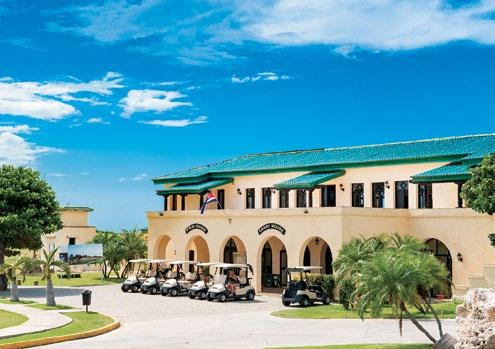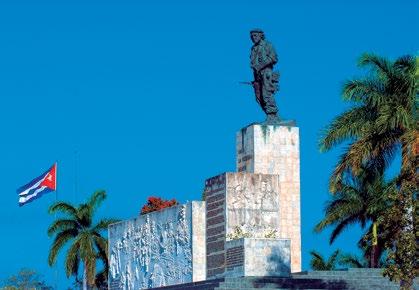
6 minute read
Matanzas
Founded on October 12, 1693 as San Carlos and San Severino de Matanzas, it is currently known as the Athens of Cuba. Photo: © Andro Liuben
Mayabeque
Created in 2010, the province of Mayabeque is made up by 11 municipalities and the city of San José de las Lajas is its capital�
Because it has more than a dozen institutes, centers and agricultural research stations, plus the Agrarian University of Havana, it is said it is a scientific power�
Also of importance are the famous Havana Club rum factories, in the fishing town of Santa Cruz del Norte and in San José de las Lajas�
JIBACOA� Extending from el Peñón del Fraile to Bacunayagua, half way between Havana and Varadero, along the northern coast, this destination features the Jibacoa and Arroyo Bermejo beaches coveted for their rich seabed, beautiful landscapes, cliffs and exuberant vegetation�
Its accommodations include the Memories Jibacoa Hotel and Villa Trópico, both with the highest category in the province, located between the sea and the mountains� Several camping sites offer economical options for beach and nature tourism�
Matanzas
Divided into 13 municipalities, the provincial capital is the city of Matanzas� Its diversity of attractions allows it to provide a tourist product combining beach, nautical sports, city, nature and culture, since it has the famous Varadero beach resort; the Zapata Peninsula, a natural sanctuary; and the city of Matanzas, the cradle of musicians, intellectuals and artists�
CITY OF MATANZAS� Founded on October 12, 1693 with the name of San Carlos y San Severino de Matanzas, it is currently known as the Athens of Cuba, although it is also called The City of Bridges�
It is dignified by illustrious figures like poets Plácido and José Jacinto Milanés or Carilda Oliver, already in the 20th century; as well as the Sauto Theater, 2020 National Prize for Restoration, where world artists have performed�
Its cultural products alternate with natural sites like the Cuevas de Bellamar, a showcase of the passage of time over stalactites and stalagmites; and the Río Canímar Tourist Park with its ecotourism offer�
On the thruway traveling to Varadero there is the Tropicana Varadero Cabaret and the Juan Gualberto Gómez International Airport, Cuba’s second most important�
VARADERO� Located 30 km from Matanzas, in the peninsula of Hicacos, the world famous beach resort is one of the country’s most visited tourist destinations� It classified as the world’s ninth best beach in the awards of the 2020 Travellers’ Choice of TripAdvisor�
It has 22 km of beach with fine white sand and crystalline waters having a pleasant temperature the year round� Its seabed, of singular beauty, is ideal for contemplative diving and other water sports�
Two marinas operate in the beach resort, one of which, the Marina Gaviota Varadero, is set to become one of the most complete tourist ports in the Caribbean; six international scuba diving centers and a nautical base�

Varadero Golf Club, designed according to the highest international standards. Photo: © Possohh / 123RF
It has more than 50 hotels with close to 22,000 rooms (around 30% of the island’s total), with a high incidence of management by important international chains; plus a wide complementary network of restaurants, cafeterias and nightspots, of diverse formats, which guarantee numerous options�
The Varadero Golf Club, designed according to the highest international standards, has the only 18-hole par 72 professional golf course on the island, with an area of 6,269 m; the Xanadú Casa Club is located on the course�
ZAPATA PENINSULA� Classified as a Biosphere Reserve and Ramsar Site, the Península de Zapata National Park, to the south of the province, is among Cuba’s major nature and diving tourism destinations� It is one of the best conserved wetlands in the Caribbean, inhabited by many species of birds, plus other migratory ones�
Yachts leave from the Crocodile Farm, which protects more than 4,000 specimens of the Cuban crocodile (Crocodylus rhombifer), for the Laguna del Tesoro, the Guamá tourist center and its Taino Hamlet, an exact replica of a Cuban indigenous settlement with lifesize sculptures made by Rita Longa�
This area is full of history since it was the scenario of the 1961 Bay of Pigs invasion, recalled in the Playa Girón Museum�
Isla de la Juventud
It is the second largest island of the Cuban archipelago, separated from the big island by a narrow strip of sea of some 80 km� This special municipality’s capital is the city of Nueva Gerona, founded in 1830�
Famous as Treasure Island, its attractions include the black-sand beach of Bibijagua; the San Felipe-Los Indios Natural Reserve; the indigenous Punta del Este cave paintings; and historic sites such as El Abra estate and the Model Prison�
CAYO LARGO DEL SUR� Located on the eastern tip of Los Canarreos archipelago, Cayo Largo, the area’s principal tourist destination, takes up a land area of 37 km² and is 25 km long�
Its main attractions are its virgin beaches, especially Sirena and Paraíso, two of the best preserved in the world, according to
the magazine National Geographic; especially Playa Paraíso, ranked third among the 25 best in the World in TripAdvisor’s Travellers’ Choice 2020 awards�
The coral reefs that border the key outline an impressive submerged scenario� A modern hotel plant, an international marina, an international scuba diving center and an international airport operate there in full harmony with the ecosystem�
Central Region
It includes five provinces: Villa Clara, Cienfuegos, Sancti Spíritus, Ciego de Ávila and Camagüey� Renowned tourist centers of interest, some of them already with a leading position and others of recent development, alternate in the region: Guamuhaya, the principal mountain range in the center of the island; Cayo Coco and Cayo Guillermo, in Jardines del Rey; Cayos de Villa Clara; Jardines de la Reina National Park; Santa Lucía beach; and the historic centers of Trinidad, Cienfuegos and Camagüey� Its emblematic festivity, the Parrandas of Cuba’s central region, were declared a Master Work of World Oral and Immaterial Heritage�
Villa Clara
Divided into 13 municipalities, its capital is the city of Santa Clara, founded in 1689 and located in the heart of the island�
Related in its recent history to the figure of Ernesto Che Guevara, to the point of being known as “Che’s city,” the Memorial where the mortal remains of the legendary guerrilla fighter rest is located there�
La Caridad Theater, the Leoncio Vidal Park and the Monument to the Armored Train are historic and cultural sites emblematic of the city� Other places of interest in the rest of the province include the mineral-medicinal waters and thermal resort of Elguea; the Hanabanilla artificial lake, located in the mountains of the Sierra del Escambray; the city of Remedios, cradle of the famous fiestas called Parrandas; and Sagua la Grande, an emerging circuits destination�
It can be accessed by the country’s two principal highways, the National Thruway and the Central Highway, which converge in Santa Clara, or through its Abel Santamaría International Airport�
SAGUA LA GRANDE� Founded officially on December 8, 1812� Cradle of prestigious
Santa Clara is known as “Che’s city” and is home to the Memorial where his mortal remains rest.










